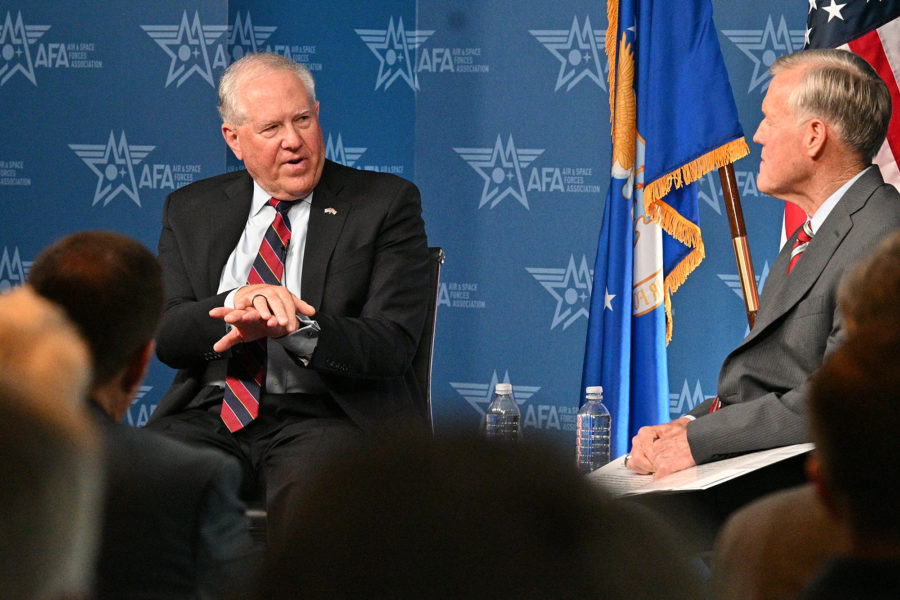The crewed, central platform of the Next Generation Air Dominance system won’t follow early timetables that called for new versions to be fielded about every five years because it’s simply too complex, Air Force Secretary Frank Kendall revealed. And while the program has entered formal development, it is still in competition, he said.
Speaking at an AFA “Leaders in Action” event, Kendall noted that the NGAD started in 2014 and got under contract the following year, with the goal of producing “X-planes—demonstrators.” That phase of the program was carried out “in a reasonable timeframe for that kind of program,” he said.
But “the NGAD that we’re working on now … is going to take longer. It’s a more complicated operation to have a manned aircraft” that will be the follow-on to the F-22.
“It’s not a simple design,” he emphasized.
Former Air Force acquisition executive Will Roper envisioned an NGAD program on a rapid rhythm of yielding a new core platform every five years or so, with production runs of up to just 100 airplanes, giving the industry regular and frequent opportunities to propose and build cutting-edge aircraft. When one entered production, the next one would already be in development, under Roper’s vision.
But while Kendall said, “I have a lot of respect for Will Roper. I’ve worked with him a lot, [and] I think he has some really interesting ideas … I think you have to be careful about where you apply those ideas.”
It’s a “long, hard job to build” an aircraft like the F-35 that represents “a whole generation of better capability” than the aircraft it replaces, Kendall asserted.
That is a “different animal entirely” from quick-turnaround programs with “some base functionality” that are upgraded with modular improvements, Kendall said.
The latter approach will be taken with the uncrewed aircraft that will comprise the rest of the NGAD “family” of systems, which Kendall said would be a “formation” of up to five additional, autonomous aircraft in addition to the crewed central platform.
For the uncrewed combat aircraft, “the concept is to have a more modular design, much less expensive,” and certainly lacking “all the systems a manned aircraft needs to have to support the operator.” It will have “just those things it needs for whatever we’re asking it to do.”
There’s “a suite of sensors; there’s a suite of weapons; there’s connectivity between them; there’s connectivity to the weapons; there’s offboard support that will provide targeting and situational awareness information to that operator who’s trying to control this formation,” Kendall explained.
“That operator will need a lot of … automated help to do his job effectively, but I think it’s going to be a very powerful concept,” he insisted.
Kendall said that for “both kinds of platforms, I think we can do a much quicker refresh, technologically. And I think we should.”
But doing that quick-refresh is “much harder to do … for something that has the complexity … [and] requirements” of the F-22 or F-35, for example, Kendall said.
Recently, Kendall revealed that the NGAD has entered the engineering and manufacturing development phase. When asked if that means a single contractor has been chosen to build the NGAD airplane, Kendall said, “it’s a classified program” but “we still have competition.” That suggests that at least two contractors have been brought forward into development to further reduce risk. In some recent programs, two contractors were carried to the point of critical design review.
Expanding on the NGAD concept, Kendall said the crewed aircraft will be the “play caller, the quarterback,” while the others will perform tailored missions using modular sensors, with all the platforms, and their weapons, connected and functioning as a team.
“You have an interesting virtue with that kind of formation in that you’re willing to put at high risk some elements of the formation because you don’t have people in them,” Kendall said. “And that opens up a suite of tactics that, today, would be unthinkable.”
Kendall said he is convinced “this is going to happen. I have no doubt this is going to happen, and somebody’s going to get there first, and somebody’s not. I want [the Air Force] to be first.”
The uncrewed aircraft will rely on further development of the Skyborg unmanned aircraft piloting system as well as further advances in artificial intelligence and software, Kendall said, acknowledging that “software … is hard.”
Nevertheless, “I think we can get to a meaningful level of initial capability. And then we’ll build on that. And we’ll have a foundation on which to build.”
He said the development of the AI as applied to these new uncrewed airplanes will be “exciting to watch” as these systems mature in the next few years.
Kendall reiterated that the program is going ahead toward actual, deployable hardware as swiftly as possible.
“I’m not doing this as an experiment. I’m doing it as a real program. We’ve done an awful lot of experimentation, prototyping, and virtual planes and so on, over the last few years … I’m all about real capability. I’m all about putting meaningful capability in the hands of warfighters as quickly I can.”
